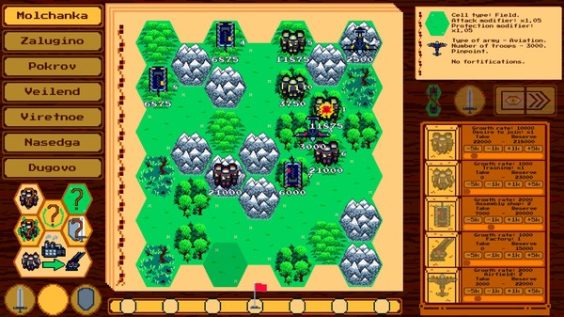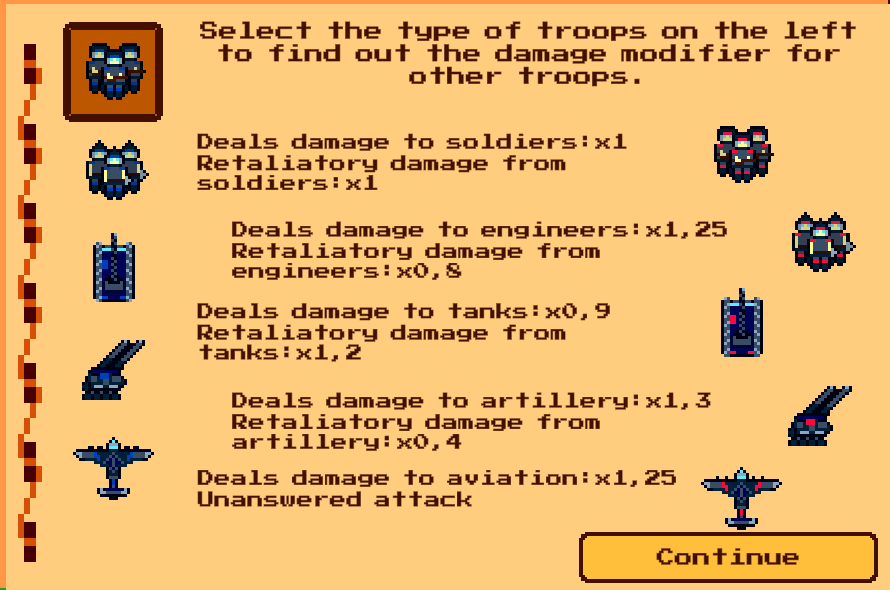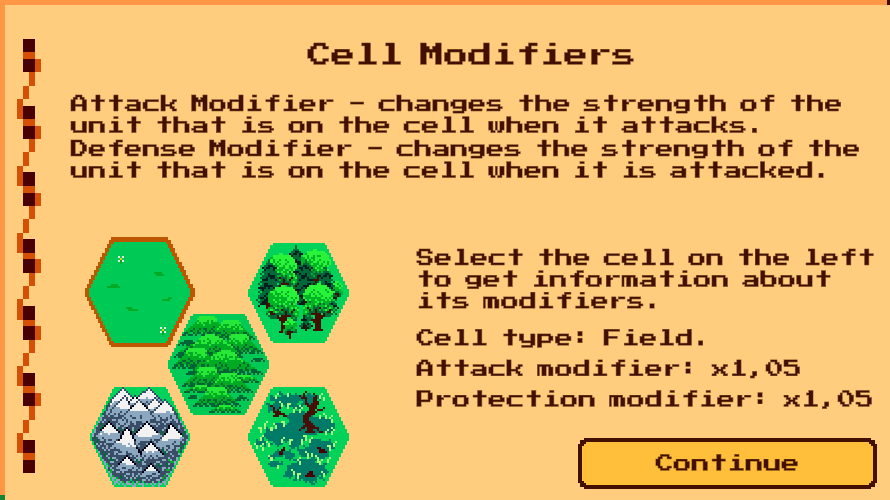
In this guide, I will talk about the system for taking damage in the game. And also about how it depends on randomness and how it can be controlled.
Preface
I thought that someone might be more interested in how it all works inside. In the game, I formulated everything clearly, but some of the features most likely have to be understood independently. In addition, such information would be an overload for normal training. And if you are curious and you do not mind the mountain of text – then get a mountain of text))))
First movement – then attacks
All units on the battlefield first make movements. The order depends on the initiative of each individual squad (which changes every turn). This way you don’t have to worry that you won’t have time to retreat. It also allows you to catch strong enemy units so that they do not have time to get close to your key units.
Note that this complicates the management of artillery and aircraft – they only hit the selected cell if there is an enemy unit at the time of the attack. I.e., you need to anticipate the actions of the opponent. Therefore, this technique is more convenient to shoot at surrounded units that will not be able to change their position.
1 squad – 1 attack
Any of your squad during the battle has exactly 1 opportunity to attack. And this opportunity may be lost if the enemy unit attacked you first. Then your squad begins to defend itself in response, but it will not do anything on its turn.
The exception is unrequited attacks. They do not take away the unit’s ability to attack, because it did not defend itself. That is, if your unit was attacked by artillery, and then a tank, then it will still be able to make an attack on its turn. But aviation does not have an unrequited attack. This means that if you use it correctly, you can prevent the enemy squad from hitting your key targets ahead of time.
The number of defensive actions of the squad is not limited, i.e. it can respond to each NON-response attack.
How does the damage pass and when does it count?
Your individual squad takes damage when interacting with the enemy. You don’t take damage if you hit with an unanswered attack, and the enemy squad didn’t attack you during the same turn.
From this we can also conclude that tanks with an early initiative can attack the same squad twice – the first time during their turn, and the second time when defending against an enemy attack.
Damage is always counted after all attacks on the battlefield. This means that if your squad was attacked from all sides, it will respond to each offender in full force. On the other hand, the damage of the opponents will be added when counting. And if initially your squad was seemingly 4 times stronger, then after the battle it may not be so.
Coefficients – is it difficult?
No.
Those that pass between the units can always be viewed in the game’s hint. And the most unusual ones are related to long-range equipment. In the battle itself, you can not particularly influence them, but you should not forget about them.

But what you can influence is the choice of the location of the squad. The damage that comes from your squad always depends only on the cell on which it is located. That is, you do not care WHAT you are attacking, or WHAT you are defending against, to understand your damage, it is enough to know from which cell you are doing it.

The cell on which the opponent stands only affects HIS damage to you. If it’s the mountains, then let him attack first. If there are hills-try to retreat and lead him into the swamp. This, of course, is worth doing if you are worried about your squad.
Looking ahead, your task is to score, along with the damage coefficients, 2 or 4 times more than the number of the unit you attacked. However, you don’t need to compare this to the damage to you, because it is completely different. If you have 1 squad and he is a little short of overcoming x2 or x4, then it is better to choose a convenient position for him. Or turn on the defense mode if he is standing on a mountain, and he has a small initiative (he turn before the opponent’s squad).
Numbers
So, let’s imagine your squad of 10,000 soldiers. During the turn, it was attacked by a squad of 38,110 enemy soldiers from the “Field” cell. Since according to the table, the soldiers deal x1 damage to each other, and the field gives x1. 05, then the enemy’s damage 38.110 * 1 * 1.05 = 40.015. This is 4 times more than the number of our squad.
The damage it will take is based on randomness
With a 25% chance: the squad will be completely destroyed at the end of the turn
With a probability of 25%: there will be losses of 75%, i.e. about 2,500 soldiers will remain from the squad. The squad will also begin to retreat.
With a probability of 25%: there will be losses of 50%, i.e. about 5,000 soldiers will remain from the squad. The squad will also begin to retreat.
With a probability of 25%: there will be losses of 30%, i.e. about 7,000 soldiers will remain from the squad.
If the enemy’s squad had 38.090 soldiers (i.e. 20 less), then its damage would be 38.090 * 1 * 1.05 = 39.994. This is not more than our squad 4 times, but more than 2. Then the damage we will receive will be as follows:
With a probability of 25%: there will be losses of 50%, i.e. about 5,000 soldiers will remain from the squad. The squad will also begin to retreat.
With a probability of 25%: there will be losses of 30%, i.e. about 7,000 soldiers will remain from the squad.
With a probability of 25%: there will be losses of 25%, i.e. about 7,500 soldiers will remain from the squad.
With a probability of 25%: there will be losses of 15%, i.e. about 8,500 soldiers will remain from the squad.
Next, imagine a rainbow and 2 identical warring squads of 10,000. Then the damage to one of them will be:
With a probability of 25%: there will be 25% losses, i.e. approximately 7,500 soldiers will remain from the squad.
With a probability of 25%: there will be losses of 15%, i.e. about 8,500 soldiers will remain from the squad.
With a probability of 25%: there will be a loss of 10%, i.e. about 9,000 soldiers will remain from the squad.
With a probability of 25%: there will be losses of 5%, i.e. about 9.500 soldiers will remain from the squad.
This situation is the most unpredictable. But in the ideal case for one of the squad, it comes down to superiority for 3 moves. 1: 7.500 vs 9.500; 2: 5.625 vs 9025; 3: 4218 vs 8573. And during this time, a lot can change.
Now let’s go back to our favorite group of 10,000 soldiers, which is so fiercely terrorized by enemies in the amount of 38,090. We still don’t know what it stands on, because it didn’t matter to us, because we studied the damage from it. Now let’s see what we can say to this military machine. We know that the enemy attacked him. Suppose our squad is standing on a mountain. Then its return damage on the enemy – 10.000 * 1 * 1.5 = 15.000. This number is more than 2 times less than the opponent’s soldiers (38.090 / 2 = 19,045). But it’s bigger than your opponent’s soldiers / 4 (38.090 / 4 = 9.522). This means that the damage to the enemy will be as follows:
With a probability of 25%: there will be losses of 10%, i.e. about 34,281 soldiers will remain from the squad.
With a probability of 25%: there will be losses of 5%, i.e. about 36,185 soldiers will remain from the squad.
With a probability of 25%: there will be losses of 3%, i.e. about 36,947 soldiers will remain from the squad.
With a probability of 25%: there will be losses of 2%, i.e. about 37,328 soldiers will remain from the squad.
Not bad. At best, you can give it a good thrashing. But what happens if you love the swamp so much that you prefer it to the mountain? Then your damage will be quite low, namely 10.000 * 1 * 0.75 = 7.500. And this is already less than a quarter of the enemy’s strength (38.090 / 4 = 9.522). Then we will do almost no damage to the enemy:
With a probability of 25%: there will be losses of 3%, i.e. about 36,947 soldiers will remain from the squad.
With a probability of 25%: there will be losses of 2%, i.e. about 37,328 soldiers will remain from the squad.
With a probability of 25%: there will be losses of 1%, i.e. approximately 37,709 soldiers will remain from the squad.
With a probability of 25%: there will be no losses.
But you don’t like the swamp, right?
Retreat!
I will explain the principles of retreat of any detachments and why it is not necessary to prop up detachments.
You already know the reasons for the retreat of the troops. And now how they do it – they try to retreat to one of the three squares behind them (for the enemy it is up, for the player-down). Next, if it is not occupied by the same type of troops, then they choose from the cells on the left and right in the direction of your front. If all the cells are occupied by troops of a different type (soldiers around the tank, for example), then the squad remains in place, but immediately receives damage as if it was attacked by an enemy 2 times stronger than it (see above). He will not retreat a second time.
Thus, blocking a strong squad can snowball all your plans. After all, if the enemy pounces on him and can inflict a little more x2, then he already has a chance to retreat. And when blocked, it will take twice the damage as x2.
Defensive structures
This is quite a cool thing, because the only thing that increases your number of soldiers when calculating damage to you. Do not forget that they are built during the movement of troops only by engineers and only if they are defending themselves and did not move in this turn. On the other hand, engineers can be perfectly fixed in positions, if there are enough of them to build the strongest possible structure every turn. The maximum coefficient is 50%.
The modifier indicates how much the building protects. At the same time, a fully constructed structure is enough for 2 enemy attacks (not for 1 turn, but for 2 separate ones). It seems that a little, but if you recall the example with 10,000 soldiers, then the enemy needs 60.001 soldiers to deal damage to x4. And already 29.999 soldiers deal damage to the squad as an equal.
Also, the disadvantages include the fact that the structures remain on the cell. And if your squad retreated, and in the next moves the initiative was for the enemy, then he can have time to take your trenches.
Structures do not count for double damage from retreating and are not destroyed by this damage.
Conclusions
Try to gain x4 damage, and make sure that the enemy does not gain such damage on your key units. Also know that even a small partisan detachment of 1,000 is able to hold off the pressure of a huge army for 3 moves with the support of luck.
If you read this and you were at least a little interested, I would be happy to see some feedback on this information.
Here we come to an end for Generals. Positional Warfare Battle system hope you enjoy it. If you think we forget something to include or we should make an update to the post let us know via comment, and we will fix it asap! Thanks and have a great day!
- Check All Generals. Positional Warfare Posts List


Leave a Reply